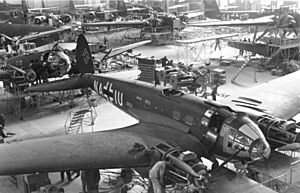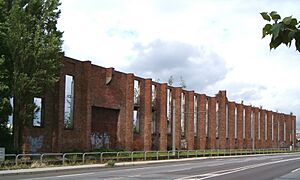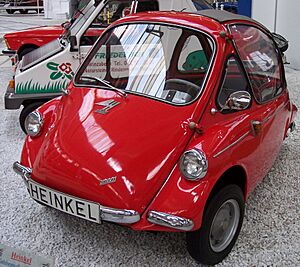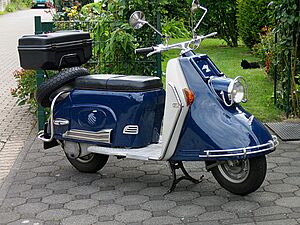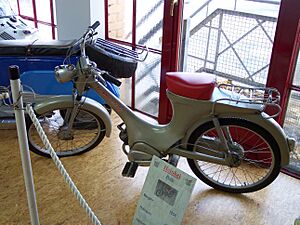Heinkel facts for kids
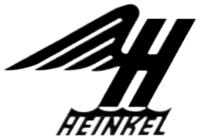 |
|
| Industry | Aerospace |
|---|---|
| Fate | Acquired |
| Successor | Vereinigte Flugtechnische Werke (VFW) |
| Founded | 1922 |
| Founder | Ernst Heinkel |
| Defunct | 1965 |
| Headquarters |
Warnemünde, Mecklenburg-Vorpommern
,
|
|
Key people
|
Robert Lusser |
| Services | Aircraft engines |
Heinkel Flugzeugwerke was a German company that made airplanes. It was started by Ernst Heinkel. This company is famous for making bomber aircraft for the German air force, called the Luftwaffe, during World War II. Heinkel also made big steps in creating very fast planes. They built the first successful plane powered by a liquid-fueled rocket and the first plane powered by a turbojet engine. Both of these amazing planes flew for the first time just before World War II began in Europe.
Contents
History of Heinkel Aircraft
After a successful career designing planes in World War I, Ernst Heinkel started his own company in Warnemünde in 1922. This was possible because rules about German aviation were relaxed after the Treaty of Versailles.
By 1929, Heinkel's special catapults, which used compressed air, were used on German ocean liners. These catapults helped launch small mail planes from the ships' decks. This made mail delivery much faster across the ocean.
Early Aircraft Designs
Heinkel's first big success after World War I was the Heinkel He 70 Blitz (Lightning). This was a fast, all-metal plane with one engine. It was used for mail and passengers by Deutsche Luft Hansa in 1932. The Blitz broke several speed records for its type.
Next came the Heinkel He 111 Doppel-Blitz (Double Lightning), which had two engines. This plane became a very important bomber for the Luftwaffe during World War II. Key designers at Heinkel during this time were the twin brothers Siegfried and Walter Günter, and Heinrich Hertel.
The company's main office was in Rostock, in a part of the city now called Schmarl. They also had an airfield nearby. Later, after Germany took over Austria in 1938, Heinkel opened a second large factory in Schwechat, Austria.
Heinkel in World War II
Heinkel is most known for the planes it made for the Luftwaffe during World War II. They turned the He 70 and especially the He 111 into bombers. Heinkel also made the Heinkel He 177, which was the Luftwaffe's only heavy bomber. However, not many of these were used in battle.
These bombers, like the He 111 and He 177, were equipped with advanced navigation systems. These systems, developed by Johannes Plendl, helped planes fly at night. Similar technology is common in all commercial airplanes today.
Heinkel had less success with fighter planes. Before the war, their Heinkel He 112 fighter was not chosen. Instead, the Messerschmitt Bf 109 was picked. Heinkel's attempt to make an even better fighter, the Heinkel He 100, also failed due to political reasons.
The company did create an excellent night fighter, the Heinkel He 219. But again, politics limited how many were made. The He 219 was special because it was the first German front-line plane to have tricycle gear (a landing gear with a nose wheel and two main wheels). It was also the world's first military plane to use ejection seats, which allowed pilots to escape quickly in an emergency.
On the other hand, the Heinkel He 177 Greif (Griffon) heavy bomber had many problems. Its engines often caught fire, and its design was not suitable for the dive-bombing attacks the German Air Ministry wanted it to do.
From 1941 until the end of the war, Heinkel joined with an engine maker called Hirth. This new company, Heinkel-Hirth, could now make its own engines, including jet engines.
Heinkel was a leader in developing jet engines and rockets. They also tried to make planes with retractable tricycle landing gear more common. In 1939, test pilot Erich Warsitz flew the Heinkel He 176 and Heinkel He 178. These were the first planes to fly using liquid-fuel rocket power and jet engine power, respectively.
Heinkel was also the first to develop a jet fighter prototype, the Heinkel He 280. This was the first Heinkel plane to use and fly with retractable tricycle gear. However, the He 280 never went into full production. The German Air Ministry wanted Heinkel to focus on making bombers instead. They also preferred the rival Messerschmitt Me 262 jet fighter.
Very late in the war, Heinkel's single-jet fighter, the Heinkel He 162A Spatz (sparrow), finally flew. It was the first military jet to use retractable tricycle landing gear, a turbojet engine from its first flight, and an ejection seat from the start. But it barely entered service before Germany surrendered.
Heinkel and Wartime Labor
During World War II, Heinkel used many prisoners from the Sachsenhausen concentration camp for labor. Between 6,000 and 8,000 prisoners were forced to work on building the He 177 bomber.
After the War
After World War II, Heinkel was not allowed to make aircraft. So, they started building bicycles, motor scooters, and a tiny car called the Heinkel microcar.
In the mid-1950s, Heinkel was allowed to make aircraft again. They built F-104 Starfighters under license for the West German air force. In 1965, Heinkel became part of another company, Vereinigte Flugtechnische Werke (VFW). Later, VFW joined with Messerschmitt-Bölkow-Blohm in 1980, which eventually became part of Airbus.
The company also designed a special aircraft called the Heinkel He 231 (VJ 101A). This plane was designed to take off and land vertically (like a helicopter) to protect West Germany's airfields from attack.
Heinkel Products
Aircraft Designs
Heinkel designed and built many types of aircraft. Here are some of the notable ones:
- Heinkel He 45: A bomber and trainer plane.
- Heinkel He 46: Used for reconnaissance (scouting).
- Heinkel He 50: A reconnaissance and dive bomber biplane.
- Heinkel He 51: A fighter and close-support biplane.
- Heinkel He 59: A reconnaissance seaplane (lands on water).
- Heinkel He 60: A seaplane used on ships for scouting.
- Heinkel He 70 "Blitz": A fast transport and mail plane from 1932.
- Heinkel He 72 Kadett: A trainer plane.
- Heinkel He 100: A fighter plane.
- Heinkel He 111: A famous bomber plane.
- Heinkel He 112: A fighter plane.
- Heinkel He 115: A general-purpose seaplane.
- Heinkel He 116: Used for transport and reconnaissance.
- Heinkel He 176: A pioneering experimental aircraft powered by a liquid-fueled rocket.
- Heinkel He 177 Greif: Germany's only long-range heavy bomber during WWII.
- Heinkel He 178: The world's first aircraft powered by a jet engine.
- Heinkel He 219 Uhu: A night-fighter plane.
- Heinkel He 280: An experimental jet-engined fighter.
- Heinkel He 162 Spatz: A jet-engined fighter, also known as the "People's Fighter."
Microcar: The Heinkel Kabine
In 1956, Heinkel introduced a small car called the "Kabine." It was a "bubble car" that competed with other tiny cars like the BMW Isetta. The Kabine had a single-cylinder, four-stroke engine.
Heinkel stopped making the Kabine in 1958. However, other companies continued to build it under license until 1966.
Scooters: The Heinkel Tourist
In the 1950s, Heinkel also started making motor scooters. The "Tourist" scooter was known for being very reliable. It was a large, heavy scooter designed for touring. It had good protection from the weather and a streamlined shape, which made sense given Heinkel's background in aircraft design.
Even though it had a small 174 cc engine, the Tourist could reach speeds of up to 70 mph. Heinkel also made a lighter 150 cc scooter called the Heinkel 150.
Mopeds: The Heinkel Perle
From 1954 to 1957, Heinkel built a moped called the Perle. The Perle was a very advanced moped for its time. It had a special frame, rear suspension, and wheels that could be easily changed. This high quality made it quite expensive. Like most mopeds, it had a 50cc two-stroke engine that ran on a mix of gasoline and oil. About 27,000 Perles were sold.
See also
- List of RLM aircraft designations
- Maicoletta
- Zündapp Bella


